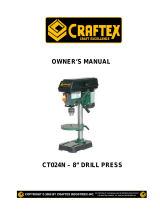
4
Read and follow all the instructions
and safety precautions in the user
manual before setup or use.
For the protection of your eyes, always
wear safety glasses, goggles or face
shield while operating the shaper.
Never place your fingers or hands in
the line of cut. If you slip, your hands
or fingers may come into contact with
the cutter. Always use a push stick
when feeding stock against the cutter.
Make sure the keyed washer is
mounted directly under the spindle
nuts.
All guards must be in place while
operating the shaper to ensure safety.
Always feed the stock smoothly
against the rotation of the cutter.
Do not force the machine. It will
perform a better job at a rate for which
it is designed.
Allow the motor to reach the full speed
before feeding stock against the cutter.
Use the overhead guard when
adjustable fence is not in place.
Make sure before making any
adjustments, the switch is in the “OFF”
position and the cord is un-plugged.
Never leave the shaper unattended
while it is running.
Always use the cutters designed to be
used with CX300 and similar shapers.
Do not expose the shaper to rain or use
in damp locations.
Clean and sharp tools give safer and
better performance. Dull cutters can
cause kick backs and excessive chatter.
Always check the cutter and other parts
for proper adjustment before cutting
operation.
Always make sure that your shaper is in
a stable position. Cutting heavy, long
stock may alter the stability of the
shaper. In the event that this may occur,
the shaper should be firmly bolted to the
floor.
Do not wear loose clothing, neckties,
jewelry or gloves that can get caught in
moving parts. Confine long hair and
keep sleeves above the elbow.
Always use a feather board and/or hold-
downs to support your work-piece when
necessary.
Make sure you have read and
understood all the safety instructions in
the manual and you are familiar with
your shaper, before operating it. If you
fail to do so, serious injury could occur.
CX300 – DELUXE SHAPER
SPECIFIC SAFETY INSTRUCTIONS
WARNING
The safety instructions given above can not be complete because the environment in
every shop is different. Always consider safety first as it applies to your individual
working conditions.






















